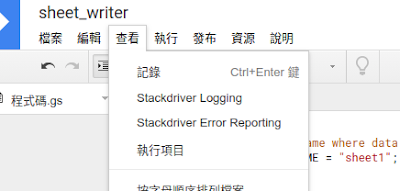Apps Script的小程式片斷
返回純文字 return ContentService.createTextOutput('純文字'); 返回純HTML return HtmlService.createHtmlOutputFromFile("html-name"); 返回沒有帶參數得template return HtmlService.createTemplateFromFile("template-name").evaluate(); 在template-name.html裏面可以穿插呼叫的程式碼,以 <? 起頭, ?> 結尾;如果要輸出值則是 <?= 起頭, ?> 結尾。通常template只有call函數的會使用這個,不然都會寫成下面的作法。 返回有帶參數得template var template = HtmlService.createTemplateFromFile("template-name"); template.you_defined_var = 'value1'; template.you_defined_var2 = 'value2'; return template.evaluate(); 這樣在template-name.html內就可以用you_defined_var和you_defined_var2這兩個變數。 返回JSON var your_json = { 'key1' : 'value1' }; return ContentService.createTextOutput(JSON.stringify(your_json)) .setMimeType(ContentService.MimeType.JSON); 這個最常做的就是下面取得sheet的資料 返回整個sheet的資料JSON格式 var sheet = SpreadsheetApp.openById(SpreadsheetID).getSheetByName(SheetName); var da

